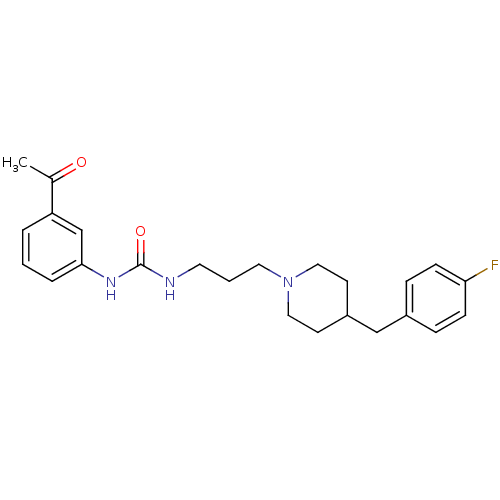BDBM50115023 1-(3-Acetyl-phenyl)-3-{3-[4-(4-fluoro-benzyl)-piperidin-1-yl]-propyl}-urea::CHEMBL295832
SMILES CC(=O)c1cccc(NC(=O)NCCCN2CCC(Cc3ccc(F)cc3)CC2)c1
InChI Key InChIKey=JSUGTZOUOKXRQN-UHFFFAOYSA-N
Activity Spreadsheet -- Enzyme Inhibition Constant Data from BindingDB
 Found 4 hits for monomerid = 50115023
Found 4 hits for monomerid = 50115023
Target5-hydroxytryptamine receptor 2A(Homo sapiens (Human))
Bristol-Myers Squibb Pharmaceutical Research Institute
Curated by ChEMBL
Bristol-Myers Squibb Pharmaceutical Research Institute
Curated by ChEMBL
Affinity DataKi: 193nMAssay Description:Inhibition of [125I]-eotaxin binding to serotonin 5-hydroxytryptamine 2A receptorMore data for this Ligand-Target Pair
TargetC-C chemokine receptor type 3(Homo sapiens (Human))
Pharmaceutical Research Institute
Curated by ChEMBL
Pharmaceutical Research Institute
Curated by ChEMBL
Affinity DataIC50: 10nMAssay Description:Inhibition of eotaxin-induced chemotaxis of human eosinophilsMore data for this Ligand-Target Pair
TargetC-C chemokine receptor type 3(Homo sapiens (Human))
Pharmaceutical Research Institute
Curated by ChEMBL
Pharmaceutical Research Institute
Curated by ChEMBL
Affinity DataIC50: 10nMAssay Description:In vitro inhibition if C-C chemokine receptor type 3 (CCR3) using 150p M [125I]-labeled human eotaxinMore data for this Ligand-Target Pair
TargetC-C chemokine receptor type 3(Homo sapiens (Human))
Pharmaceutical Research Institute
Curated by ChEMBL
Pharmaceutical Research Institute
Curated by ChEMBL
Affinity DataIC50: 10nMAssay Description:Inhibitory concentration against C-C chemokine receptor type 3 using human [125I]-eotaxin.More data for this Ligand-Target Pair
